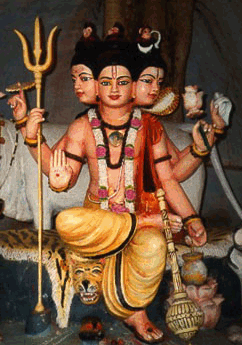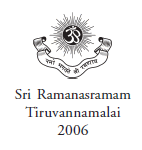

Publishers Note:
Tripura Rahasya is an ancient prime text on Advaita in Sanskrit and was highly commended by Bhagavan Sri Ramana Maharshi for study by seekers. There was no English translation of this scripture until the present one was made by Munagala Venkataramiah (Swami Ramanananda Saraswathi) in 1938.
This book is not to be picked up, read through and put away. The verses are full of Divine nectar which will quench the thirst of any earnest seeker who repeatedly reflects on their meaning and in right earnest attempts to implement the teachings.
Through fascinating stories and analogies the entire spectrum of spiritual pursuit and attainment is laid out in clear terms for the aspirant.
Tripura Rahashya is a valuable addition to the Advaitic texts published by Sri Ramanasramam, and we take great pleasure in releasing this new edition for the benefit of all those who sincerely seek to know the true nature of the Self.
25-4-2006 SRI RAMANASRAMAM
56th Aradhana Day Tiruvannamalai

INTRODUCTION
Sri Tripura Rahasya is an ancient work in Sanskrit which has been printed all over India. The latest and best edition was brought out in the Kashi Sanskrit Series in 1925. The book is said to have been printed once before and issued in loose leaves. There was also an edition in book form printed in Belgaum towards the end of last century.* (The original Sanskrit text unfortunaeely appears to have been out of print for some years.)
The esteem in which the work is held for its sanctity may be gauged from an account of it given in the Preface to the Maahaatmya Khanda. Mahaadeeva originally taught the Highest Truth to Vishnu who in turn taught Brahma in the Celestial regions. Later Vishnu incarnated on Earth as Sri Dattaatreya, the Lord of the Avadhuutas (the naked sages), and taught it to Parasuraama with the added injunction that it should be communicated to Haritaayana who would later seek the Truth from him. Parasurama thus realised the Self by the guidance of Sri Datta and dwelt on the Malaya Hill in South India.
In the meantime, a Brahmin, by name Sumanta, living on the banks of the Sarasvati had a son, Alarka by name, who used to hear his mother called “Aayi Aayi” by his father. Being a child, he too addressed his mother “Ai”. He died in his childhood, and his last words on his death-bed were “Ai AI” only. This sound is however sacred to the Goddess. Having been uttered in all innocence and purity of mind, it conferred unexpected merit on the dying child. He was later born as Sumedha, a son to Harita. Haritaayana is his patronymic. His spirituality developed as he grew up and he sought Parasuraama to learn the highest good from him, who in turn imparted to him the knowledge which he had gained from Dattaatreya. Parasuraama told him also that his master had predicted the compilation of the knowledge of the Highest Truth by Haritaayana for the benefit of mankind.
Haritaayana was worshipping Sri Minaakshi in the temple at Madurai in South India. Naarada appeared to him and said that he had come from Brahmalooka in order to see what Haritaayana was going to present to the world in the form of an Itihasa containing the Supreme Spiritual Truth. Haritaayana was bewildered and asked how the Saint expected it of him. Narada said: “There was an assembly of saints in Brahmalooka. Maarkandeeya asked Brahmaa about the Sacred Truth. Brahmaa said that it would be brought out by you in the form of a holy book. So I came to ask you about it.” Haritaayana was at a loss and pleaded inability to reproduce the Sacred Truth learned from Parasuraama. Naarada then meditated on Brahmaa who appeared before them and asked what the matter was. When Naarada put the whole matter before him, he turned to Haritaayana and blessed him, endowing him with the ability to produce the book at the rate of four chapters a day. He also referred to Haritaayana’s past and attributed his present inability to remember what he learnt to the casual and undisciplined utterance of the sacred syllable in his past incarnation. Brahmaa further enjoined Naarada to be the first to read Haritaayana’s work when it should be completed.
The work was thus written by Haritaayana and is also called after his name Haritaayana Samhita. It is said to consist of 12,000 slokaas in three sections – The Maahaatmya Khanda (Section on the Greatness of Srii Deevi), Jnaana Khanda (Section on Supreme Wisdom), and Charyaa Khanda (Section on Conduct). Of these the first consists of 6,687 slokaas; the second of 2,163 slokaas; and the third is not traceable. The section on Greatness contains the prelude to the work and later treats mostly of the manifestations of the Supreme Being as Durga, Kaali, Lakshmi. Sarasvati, Lalita, Kumaari, etc. and their exploits and found in Brahmaanda Puraana, Maarkandeya Puraana and Lakshmi Tantra. Its contents mostly cover the ground of Durga Saptasati and of Lalita Upaakhaayana.
Sri Vidya (worship of the Supreme Being as Goddess) has a very holy tradition traced to the Vedas. There are two principal divisions, known as — and –former was practised by Indra, Chandra, Manu, Kubeera, etc.; it is the simpler of the two and also more common. The other was practised by Lopaamudra and approved of the wise.
Sri Tripura Rahasya, otherwise Haritaayana Samhitaa, begins with “Salutations to Aum” and ends with “Tripura is only Hrim”. Aum is well known as the sacred syllable signifying the Highest Being in the abstract; so also “Hrim” is the sacred symbol of the same as the Goddess. The contents of the book are thus enclosed by these two symbols – the most sacred in the Vedas and the work is equally sanctified.
In Sutra Bhasya (the commentary on Brahma Sutras). Sri Sankara has used the story of Samvarta as found in Tripura Rahasya, in his commentary on “–” (Suutra), with approval.
There is a lucid commentary in Sanskrit on Haritaayana Samhita. It is named Tatparya Diipika and written in 4932 of Kali Era (i.e. 1831 A.D.) by one Dravida Srinivasa, son of Vydianatha Dikshita of the village of Mahapushkara in South India.
As for its philosophy, there is no real reason to distinguish it from Vedanta. Scholars however call this system the Taantri or the Saakta, and point out some apparent differences between this and Advaita Veedaanta. This system teaches that the Supreme Reality is no other than Abstract Intelligence. “Intelligence” signifies Self-luminosity and ‘Abstraction’ denotes its unlimited nature. No other agent can be admitted to exist apart from It in order to reveal It. The apparent variety is only due to Vimarsa, the gross aspect of Its absolute freedom known as Svatantra which at times unfolds the Pure Self as the Cosmos and at others withdraws Itself and remains unmanifest. Abstraction and manifestation are inherent in the Pure Self; these two aspects are given the names Siva and Sakti, respectively. There cannot be manifestation beyond the Supreme Intelligence; therefore Cosmos and the Self are only the same, but different modes of Reality. Realisation of the Truth is thus quite simple, requiring only constant remembrance on these lines (–) that Reality is not incompatible with the world and its phenomena, and that the apparent ignorance of his Truth is itself the outcome of Reality so that there is nothing but Reality.
Creation and Dissolution are cycles of Self-expression and Abstraction due to Swatantra. There are no Sankalpa-Vikalpas (modifications) in the state of dissipation and the Self remains as Chit in absolute purity and unchanging. The Self is uniform and undivided. The dispositions of the individuals of the previous Kalpa (creation) remain uncog-nised but potential, awaiting to become manifest in the alternating mode. The tendency in the direction of manifestation is Maya which later displays as Avidya (ignorance) when the predispositions are in their full swing. Chit, Maaya and Avidya are thus the same Reality. Cosmos is an expression in the medium of consciousness and thus not unreal as some would have it.
Here the Reality of the Cosmos is on account of the medium of expression, i.e., consciousness, which does not contradict the statement that forms, etc. are unreal. There is thus no fundamental difference between Tantra and Vedanta. Yet the Pandits say that Maya is made subservient to Brahma in Vedanta, that its application is limited to gross manifestation and that it is therefore gross which in ultimate analysis resolves itself into void; whereas according to Tantra, Maaya is an aspect of Reality and should resolve itself into Chit on ultimate analysis. This cannot be a valid objection. For, where does the above void rest? It must resolve itself into Chit.
The favourite example of the world being an image reflected in consciousness, as images in a mirror is common to both systems. Vide “–” in Dakshinaamoorti Stotra of Sri Sankara.
Without trying to find differences where they do not exist, let the earnest student apply the infallible test of the peace of mind brought about by the different modes of expression of the Reality and be satisfied and happy.
MUNAGALA S. VENKATARAMAIAH
(now Swami Ramanananda Saraswathi)